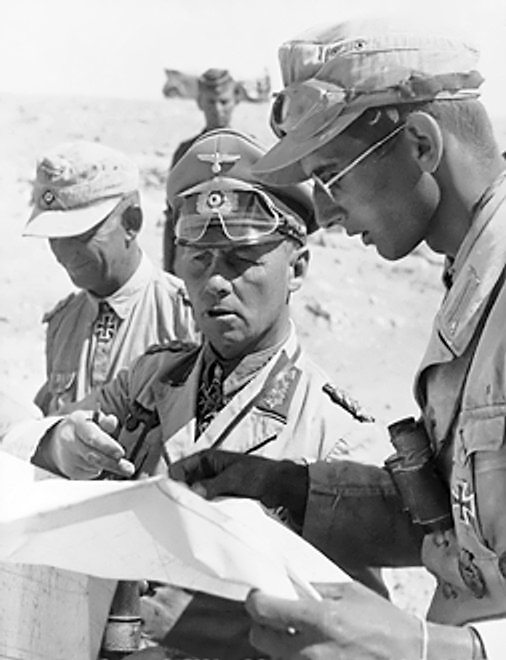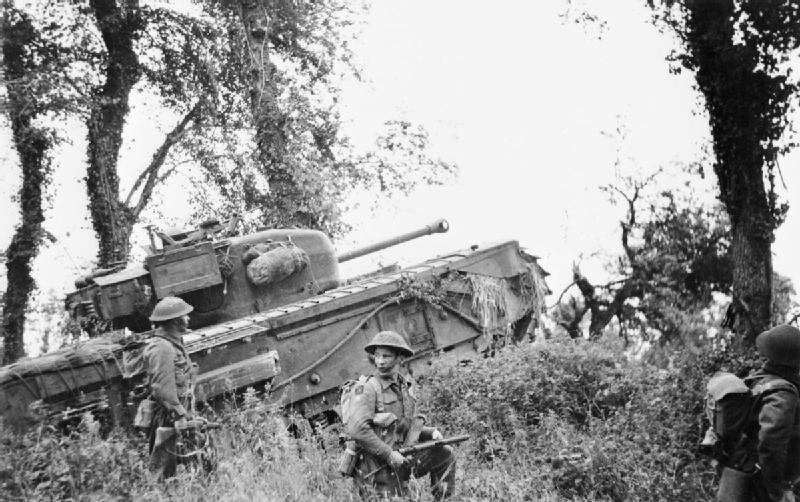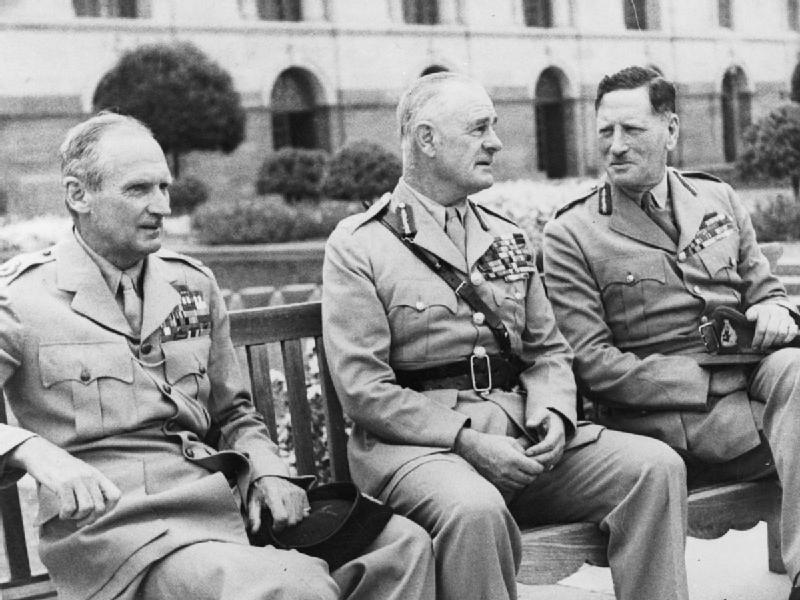|
31st Armoured Brigade
The 31st Armoured Brigade was an armoured brigade formation of the British Army, created during the Second World War. Unit history The 31st Army Tank Brigade was formed in the UK on 15 January 1941, in Northern Command and comprised the 9th Royal Tank Regiment and 10th Royal Tank Regiment. The 141st Regiment Royal Armoured Corps (141 RAC) was added on 8 November 1941 and on 29 November the brigade was transferred to South Eastern Command. In May 1942 the unit was renamed the 31st Tank Brigade and was transferred to the 53rd (Welsh) Infantry Division, as part as an experimental "mixed" formation of a tank and two infantry brigades. The experiment ended on 10 September 1943, as it was judged unsuitable for the terrain in north-western Europe. On 1 April 1943, the 10th RTR was renamed 7th Royal Tank Regiment, after the original was destroyed at the Battle of Gazala (May–June 1942). The 31st Tank Brigade, equipped with Churchill tanks, was a follow-up unit in the Normandy la ... [...More Info...] [...Related Items...] OR: [Wikipedia] [Google] [Baidu] |
Churchill Tank
The Tank, Infantry, Mk IV (A22) Churchill was a British infantry tank used in the Second World War, best known for its heavy armour, large longitudinal chassis with all-around tracks with multiple bogies, its ability to climb steep slopes, and its use as the basis of many specialist vehicles. It was one of the heaviest Allied tanks of the war. The origins of the Churchill's design lay in the expectation that war in Europe might be fought in conditions similar to those of the First World War, and thus emphasised the ability to cross difficult ground. The Churchill was hurried into production in order to build up British defences against a possible German invasion. The first vehicles had flaws that had to be overcome before the Churchill was accepted for wide use. After several Marks (versions) had been built, a better-armoured specification, the Mark VII, entered service with the British Army. The improved versions performed well in the later stages of the war. The Churchi ... [...More Info...] [...Related Items...] OR: [Wikipedia] [Google] [Baidu] |
49th Armoured Personnel Carrier Regiment
49th Royal Tank Regiment (49 RTR), later 49th Armoured Personnel Carrier Regiment and 49th Armoured Carrier Regiment, was a regiment of the British Army's Royal Armoured Corps during World War II that operated specialised armoured fighting vehicles in North West Europe. Origin and training As part of the rearmament of the British Army before World War II, the 6th Battalion Royal Northumberland Fusiliers, a Territorial Army infantry battalion, was converted to the armoured role on 1 November 1938, under the designation 43rd (6th City) Battalion, The Royal Northumberland Fusiliers, Royal Tank Regiment, or '43 RTR' for short. During 1939, it formed 49 RTR as a duplicate regiment. The regiments shared St George's Drill Hall in Newcastle upon Tyne as their depot. While 43 RTR used the conventional 'A', 'B' and 'C' squadron designations, 49 RTR adopted 'X', 'Y' and 'Z' for its squadrons.Scull. Both regiments were part of 25th Army Tank Brigade. In August 1939, 49 RTR had still not re ... [...More Info...] [...Related Items...] OR: [Wikipedia] [Google] [Baidu] |
15th (Scottish) Infantry Division
The 15th (Scottish) Infantry Division was an infantry division of the British Army that served during the Second World War. It was raised on 2 September 1939, the day before war was declared, as part of the Territorial Army (TA) and served in the United Kingdom and later North-West Europe from June 1944 to May 1945. Background During the 1930s, tensions increased between Germany and the United Kingdom and its allies. In late 1937 and throughout 1938, German demands for the annexation of the Sudetenland in Czechoslovakia led to an international crisis. To avoid war, the British Prime Minister Neville Chamberlain met with German Chancellor Adolf Hitler in September and brokered the Munich Agreement. The agreement averted a war and allowed Germany to annexe the Sudetenland. Although Chamberlain had intended the agreement to lead to further peaceful resolution of issues, relations between both countries soon deteriorated. On 15 March 1939, Germany breached the terms of ... [...More Info...] [...Related Items...] OR: [Wikipedia] [Google] [Baidu] |
Normandy Landings
The Normandy landings were the landing operations and associated airborne operations on Tuesday, 6 June 1944 of the Allied invasion of Normandy in Operation Overlord during World War II. Codenamed Operation Neptune and often referred to as D-Day, it was the largest seaborne invasion in history. The operation began the liberation of France (and later western Europe) and laid the foundations of the Allied victory on the Western Front. Planning for the operation began in 1943. In the months leading up to the invasion, the Allies conducted a substantial military deception, codenamed Operation Bodyguard, to mislead the Germans as to the date and location of the main Allied landings. The weather on D-Day was far from ideal, and the operation had to be delayed 24 hours; a further postponement would have meant a delay of at least two weeks, as the invasion planners had requirements for the phase of the moon, the tides, and the time of day that meant only a few days each month w ... [...More Info...] [...Related Items...] OR: [Wikipedia] [Google] [Baidu] |
Battle Of Gazala
The Battle of Gazala (near the village of ) was fought during the Western Desert Campaign of the Second World War World War II or the Second World War, often abbreviated as WWII or WW2, was a world war that lasted from 1939 to 1945. It involved the World War II by country, vast majority of the world's countries—including all of the great power ..., west of the port of Tobruk in Libya, from 26 May to 21 June 1942. Axis powers, Axis troops of the ( Erwin Rommel) consisting of Nazi Germany, German and Kingdom of Italy, Italian units fought the British Eighth Army (United Kingdom), Eighth Army (General (United Kingdom), General Sir Claude Auchinleck, also Commander-in-chief, Commander-in-Chief Middle East Command, Middle East) composed mainly of British Commonwealth, Indian and Free French troops. The Axis troops made a decoy attack in the north as the main attack moved round the southern flank of the Gazala position. Unexpected resistance at the south end of the ... [...More Info...] [...Related Items...] OR: [Wikipedia] [Google] [Baidu] |
7th Royal Tank Regiment
The 7th Royal Tank Regiment (7th RTR) was an armoured regiment of the British Army from 1917 until disbandment in 1959. History The 7th Royal Tank Regiment was part of the Royal Tank Regiment, itself part of the Royal Armoured Corps. The regiment originally saw action as G Battalion, Tank Corps in 1917. Part of the 1st Army Tank Brigade, 7th RTR saw service in France in May 1940, alongside the 4th Royal Tank Regiment and the 50th (Northumbrian) Infantry Division during the Battle of Dunkirk and was soon evacuated at Dunkirk, and abandoning most of their vehicles. The 7th RTR returned to England and was sent overseas later in the year. In December 1940, as part of the British Western Desert Force in Egypt, the 7th RTR contained Matilda infantry tanks and supported the 11th Indian Infantry Brigade of the 4th Indian Infantry Division. The regiment attacked and destroyed the Italian " Maletti Group" at the Nibeiwa Camp. The 7th RTR also supported the attack of the 11th Briga ... [...More Info...] [...Related Items...] OR: [Wikipedia] [Google] [Baidu] |
Combined Arms Research Library
The Combined Arms Research Library (CARL) at Fort Leavenworth, Kansas is a United States Army library that supports the United States Army Command and General Staff College. Its collection of over 300,000 books covers all aspects of military science: joint and combined operations; tactics and doctrinal development; leadership, intelligence, weapons, equipment, and training. The Archives and Special Collections house a unique collection of over 200,000 items and the documents collection consists of another 250,000. Each year, the CARL reference staff answers some 30,000 queries for soldiers, faculty and staff at Fort Leavenworth, Kansas and throughout the world via the Defense Digital Library Reference Service. Scholars, writers and the DoD community use the Combined Arms Research Library's archival materials, extensive research materials, and historical documents. The Combined Arms Research Library is one of the largest and most well respected libraries in the Army and was named th ... [...More Info...] [...Related Items...] OR: [Wikipedia] [Google] [Baidu] |
World War II
World War II or the Second World War, often abbreviated as WWII or WW2, was a world war that lasted from 1939 to 1945. It involved the World War II by country, vast majority of the world's countries—including all of the great powers—forming two opposing military alliances: the Allies of World War II, Allies and the Axis powers. World War II was a total war that directly involved more than 100 million Military personnel, personnel from more than 30 countries. The major participants in the war threw their entire economic, industrial, and scientific capabilities behind the war effort, blurring the distinction between civilian and military resources. Air warfare of World War II, Aircraft played a major role in the conflict, enabling the strategic bombing of population centres and deploying the Atomic bombings of Hiroshima and Nagasaki, only two nuclear weapons ever used in war. World War II was by far the List of wars by death toll, deadliest conflict in hu ... [...More Info...] [...Related Items...] OR: [Wikipedia] [Google] [Baidu] |
British Army During The Second World War
At the start of 1939, the British Army was, as it traditionally always had been, a small volunteer professional army. At the beginning of the Second World War on 1 September 1939, the British Army was small in comparison with those of its enemies, as it had been at the beginning of the First World War in 1914. It also quickly became evident that the initial structure and manpower of the British Army was woefully unprepared and ill-equipped for a war with multiple enemies on multiple fronts. During the early war years, mainly from 1940 to 1942, the British Army suffered defeat in almost every theatre of war in which it was deployed. But, from late 1942 onwards, starting with the Second Battle of El Alamein, the British Army's fortunes changed and it rarely suffered another defeat. While there are a number of reasons for this shift, not least the entrance of both the Soviet Union and the United States in 1941, as well as the cracking of the Enigma code that same year, an import ... [...More Info...] [...Related Items...] OR: [Wikipedia] [Google] [Baidu] |
Brigade
A brigade is a major tactical military formation that typically comprises three to six battalions plus supporting elements. It is roughly equivalent to an enlarged or reinforced regiment. Two or more brigades may constitute a division. Brigades formed into divisions are usually infantry or armored (sometimes referred to as combined arms brigades). In addition to combat units, they may include combat support units or sub-units, such as artillery and engineers, and logistic units. Historically, such brigades have sometimes been called brigade-groups. On operations, a brigade may comprise both organic elements and attached elements, including some temporarily attached for a specific task. Brigades may also be specialized and comprise battalions of a single branch, for example cavalry, mechanized, armored, artillery, air defence, aviation, engineers, signals or logistic. Some brigades are classified as independent or separate and operate independently from the traditional ... [...More Info...] [...Related Items...] OR: [Wikipedia] [Google] [Baidu] |
Armoured Warfare
Armoured warfare or armored warfare (mechanized forces, armoured forces or armored forces) (American English; see spelling differences), is the use of armored fighting vehicles in modern warfare. It is a major component of modern methods of war. The premise of armoured warfare rests on the ability of troops to penetrate conventional defensive lines through use of manoeuvre by armoured units. Much of the application of armoured warfare depends on the use of tanks and related vehicles used by other supporting arms such as infantry fighting vehicles, self-propelled artillery, and other combat vehicles, as well as mounted combat engineers and other support units. The doctrine of armoured warfare was developed to break the static nature of World War I trench warfare on the Western Front, and return to the 19th century school of thought that advocated manoeuvre and decisive battle outcomes in military strategy. World War I Modern armoured warfare began during the First Wor ... [...More Info...] [...Related Items...] OR: [Wikipedia] [Google] [Baidu] |
3rd Royal Tank Regiment
The 3rd Royal Tank Regiment (3 RTR) was an armoured regiment of the British Army in existence from 1917 until 1992. It was part of the Royal Tank Regiment, itself part of the Royal Armoured Corps. It originally saw action as C Battalion, Tank Corps in 1917. History In 1916 the Machine Gun Corps formed a Heavy Section, later Branch, in order to crew the first tanks. C Company was formed at Bisley and sent to France, after offensives in 1916 the Heavy Section became the Heavy Branch and "C" Company was expanded to Battalion strength. The Heavy Branch was then reformed in to a new Tank Corps and "C" Battalion then fought from Cambrai to the end of the war, being re-equipped with Whippet tanks in 1918. Lieutenant Cecil Sewell won the Battalion's only Victoria Cross for an outstanding act of bravery at Frémicourt in August of that year. Post war, the Tank Corps was trimmed down and received the Royal prefix with the lettered battalions being numbered and "C" became 3rd Tank Corps ... [...More Info...] [...Related Items...] OR: [Wikipedia] [Google] [Baidu] |







.jpg)
